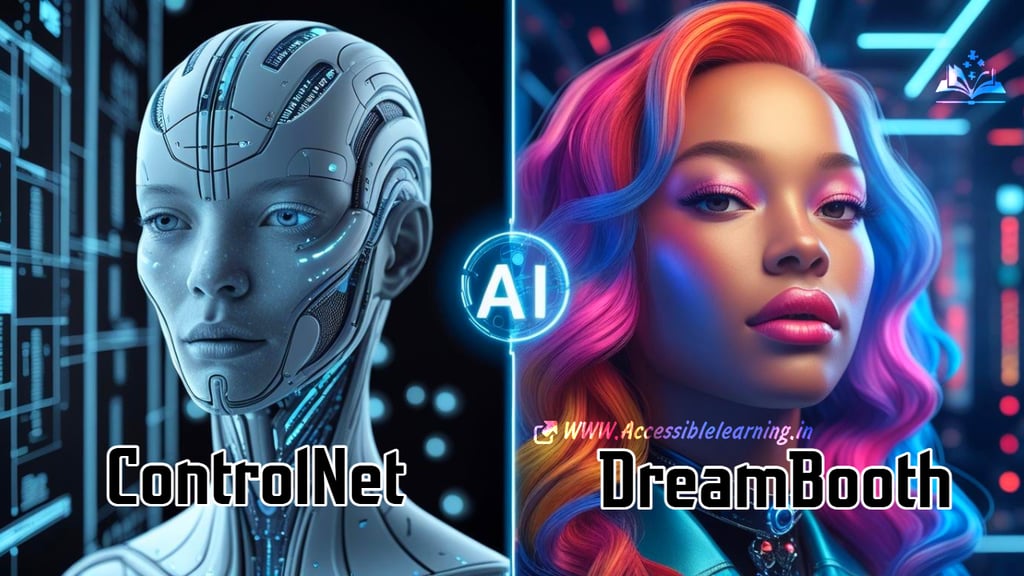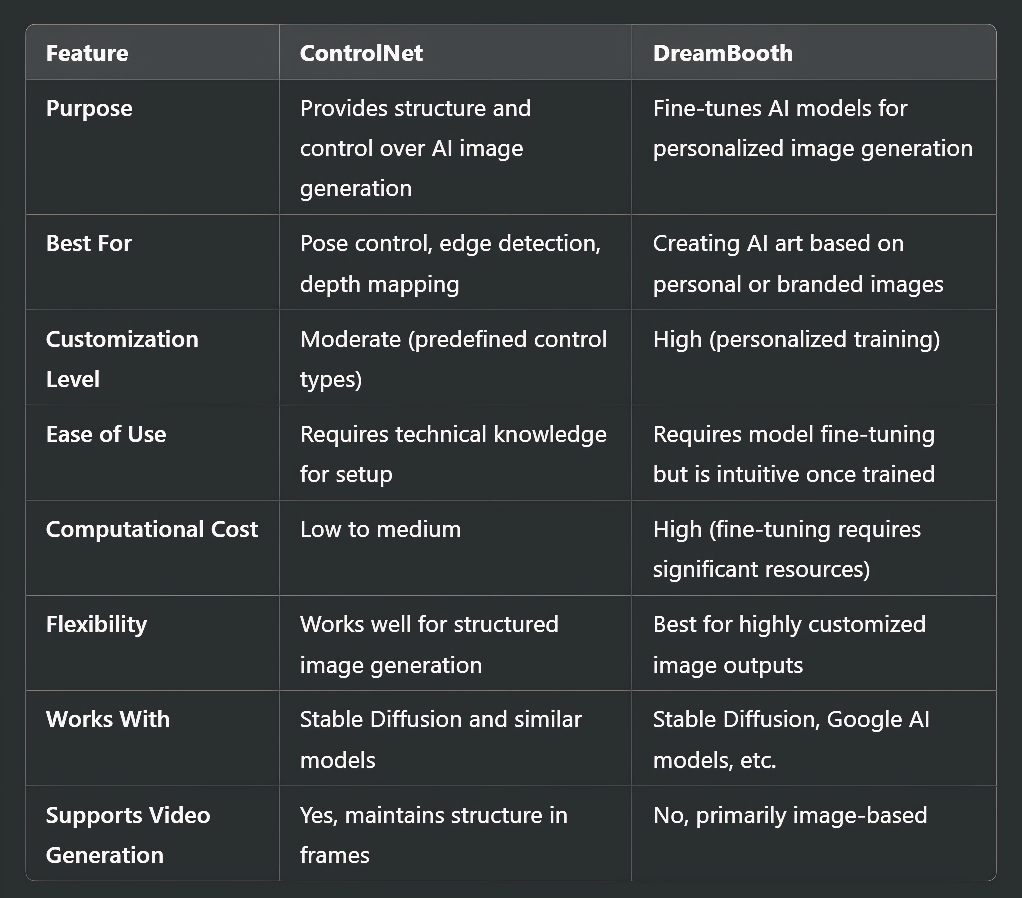
ControlNet vs DreamBooth: Which AI Tool is Right for You?
Discover the key differences between ControlNet and DreamBooth—two powerful AI tools for image generation. Learn how ControlNet ensures structured precision while DreamBooth personalizes AI-generated visuals. Find out which one is best for your creative projects!
AI/FUTURECOMPANY/INDUSTRYEDITOR/TOOLSAI ART TOOLS
Sachin K Chaurasiya
3/19/20255 min read


AI-powered image generation has seen rapid advancements, with models like ControlNet and DreamBooth emerging as popular tools for refining and personalizing AI-generated visuals. Both models serve different purposes in enhancing AI-generated art, offering users greater control and customization. But which one should you use? Let’s dive deep into the differences, use cases, and benefits of ControlNet vs DreamBooth.
What is ControlNet?
ControlNet is an extension for AI-generated image models, particularly Stable Diffusion, that allows users to impose structural guidance on the generated images. It helps maintain specific poses, edges, sketches, or depth maps while ensuring artistic creativity remains intact.
Key Features
Pose Control: Users can guide image generation using predefined human poses.
Edge Detection: Ensures images follow the contours of a reference sketch or image.
Depth Maps: Helps create a realistic perception of depth in AI-generated images.
Segmentation Mapping: Ensures different parts of an image stay aligned with user specifications.
Multi-Control Layers: Allows multiple guiding constraints simultaneously.
Can Handle Various Image Processing Tasks: Works well with sketches, segmentation maps, canny edge detection, and more.
Supports Integration with Other AI Models: Works with additional AI-based tools to improve results.
Use Cases
Creating AI-generated images with a fixed structure, ensuring accuracy in positioning and outlines.
Generating consistent characters and scenes across multiple AI-generated images.
Enhancing AI-generated animations by maintaining motion consistency.
Fashion and design prototyping, where precise control over garment shape and human poses is necessary.
Architectural Visualization, ensuring designs match blueprints accurately.
Medical Imaging Applications, aiding in AI-assisted diagnostics through controlled AI-generated outputs.
Advantages
Provides enhanced control over AI-generated images.
Maintains artistic freedom while enforcing structural accuracy.
Works seamlessly with Stable Diffusion models.
Allows for multi-layered guidance for precise image generation.
Supports a wide range of guiding inputs beyond just poses or depth maps.
Helps in creating AI-generated videos by maintaining frame consistency.
Limitations
❌ Requires technical knowledge to implement effectively.
❌ Limited to predefined control types (e.g., pose, edge, depth).
❌ Can sometimes over-constrain the generation, leading to rigid images.
❌ Not ideal for personalization as it does not train AI on new subjects.


What is DreamBooth?
DreamBooth, developed by Google Research and Boston University, is a fine-tuning method for AI-generated image models, allowing users to train models on personalized images. It enables the generation of highly customized outputs by learning specific styles, subjects, or characters.
Key Features
Personalization: Trains AI to generate images of specific individuals, objects, or styles.
Few-shot Learning: Can create custom AI art using just 3-5 reference images.
Text-to-Image Consistency: Retains subject identity while interpreting text-based prompts.
High-Fidelity Customization: Ensures facial features, colors, and textures match the reference images.
Fine-tuned Model Output: The AI learns new styles, making it ideal for branded or personal art.
Works with Multiple AI Models: Can be applied to Stable Diffusion, MidJourney, and other AI frameworks.
Creates High-Resolution Outputs: Supports generating ultra-high-definition images with fine-tuned features.
Use Cases
Custom character and portrait generation (e.g., turning personal photos into AI-generated art).
Branding and marketing assets tailored to a specific aesthetic.
Creating AI-generated avatars with high accuracy in maintaining unique features.
Artistic training for generating images in a specific painterly or photographic style.
Product Visualization, where businesses can create AI-enhanced product images using brand-specific aesthetics.
Personalized AI Assistants, integrating realistic avatars into interactive AI-driven experiences.
Virtual Try-On for Fashion, where AI can apply customized clothing designs to a specific model.
Advantages
Highly customizable and allows users to train AI on new subjects.
Works with few-shot learning, needing only a handful of images.
Provides consistent AI-generated results across various prompts.
Ideal for personalization, branding, and character generation.
Enables long-term model learning, allowing users to reuse trained models.
Can be combined with LoRA (Low-Rank Adaptation) for faster fine-tuning.
Limitations
❌ Requires a fine-tuning process, which can be computationally expensive.
❌ Time-consuming compared to prompt-based AI image generation.
❌ Can lead to overfitting, where the AI becomes too fixated on the training images.
❌ May require cloud-based GPUs or high-end local hardware for training.


Which One Should You Use?
Use ControlNet if you need structured AI-generated images where pose, depth, or edges must be controlled. Ideal for designers, animators, and technical AI artists.
Use DreamBooth if you want to train AI on specific subjects or styles, making it perfect for personalized character art, branding, and high-fidelity AI customization.
Can You Use Both Together?
Yes! Many AI artists and developers use DreamBooth to train a personalized AI model, then apply ControlNet to refine the structure of the generated images. This combination allows for both personalization and control, maximizing creativity and precision.
FAQ's
What is the main difference between ControlNet and DreamBooth?
ControlNet is designed for structural control over AI-generated images, ensuring elements like pose, edges, and depth remain consistent. DreamBooth, on the other hand, is a personalization tool that fine-tunes AI models to generate images of specific people, objects, or styles.
Which tool is better for customizing AI-generated characters?
If you want to create highly personalized characters with unique features and artistic styles, DreamBooth is the best choice. However, if you need those characters to follow strict pose and structure guidelines, ControlNet can be used alongside DreamBooth.
Can I use ControlNet and DreamBooth together?
Yes! Many AI artists use DreamBooth to train a custom model and then apply ControlNet to maintain structural accuracy while generating images. This combination helps in producing both personalized and well-structured AI-generated images.
Do ControlNet and DreamBooth require powerful hardware?
ControlNet can run on mid-range GPUs and works efficiently with Stable Diffusion models.
DreamBooth requires high-end GPUs (or cloud-based solutions) because fine-tuning an AI model demands more computational power.
Is ControlNet suitable for creating AI-generated animations?
Yes! ControlNet is ideal for AI animation workflows because it helps maintain motion consistency across frames, making it useful for AI-driven video generation.
How many reference images are needed to train DreamBooth?
DreamBooth can fine-tune a model with as few as 3-5 images, but for better accuracy, using 10-20 images is recommended.
Does ControlNet allow full artistic freedom?
ControlNet balances structure and creativity but can be restrictive if the guiding controls (like depth maps or poses) are too rigid. Artists may need to adjust parameters to retain creative flexibility.
Can DreamBooth be used for commercial branding?
Yes! DreamBooth is widely used for branding and marketing, allowing businesses to create AI-generated visuals that match their unique style.
Which tool is easier to use for beginners?
ControlNet requires technical knowledge to set up, especially for defining control maps.
DreamBooth requires AI model fine-tuning, which can be complex but is relatively intuitive once trained models are set up.
Which one should I use for high-precision designs?
If you need high-precision, structurally controlled AI-generated images, go with ControlNet. If you want personalized, creative, and artistic AI results, DreamBooth is the better choice.
Both ControlNet and DreamBooth have distinct advantages and are valuable tools for AI-based image generation. If you need precision and control, go for ControlNet. If you need customized, highly personal AI art, DreamBooth is your best bet. By understanding their differences and strengths, you can choose the right tool for your creative or professional needs!
Which one do you prefer—ControlNet or DreamBooth? Let us know your thoughts!
Subscribe To Our Newsletter
All © Copyright reserved by Accessible-Learning Hub
| Terms & Conditions
Knowledge is power. Learn with Us. 📚


